TOYOTA AYGO 2017 (in English) Owner's Guide
Manufacturer: TOYOTA, Model Year: 2017, Model line: AYGO, Model: TOYOTA AYGO 2017Pages: 480, PDF Size: 40.72 MB
Page 31 of 480
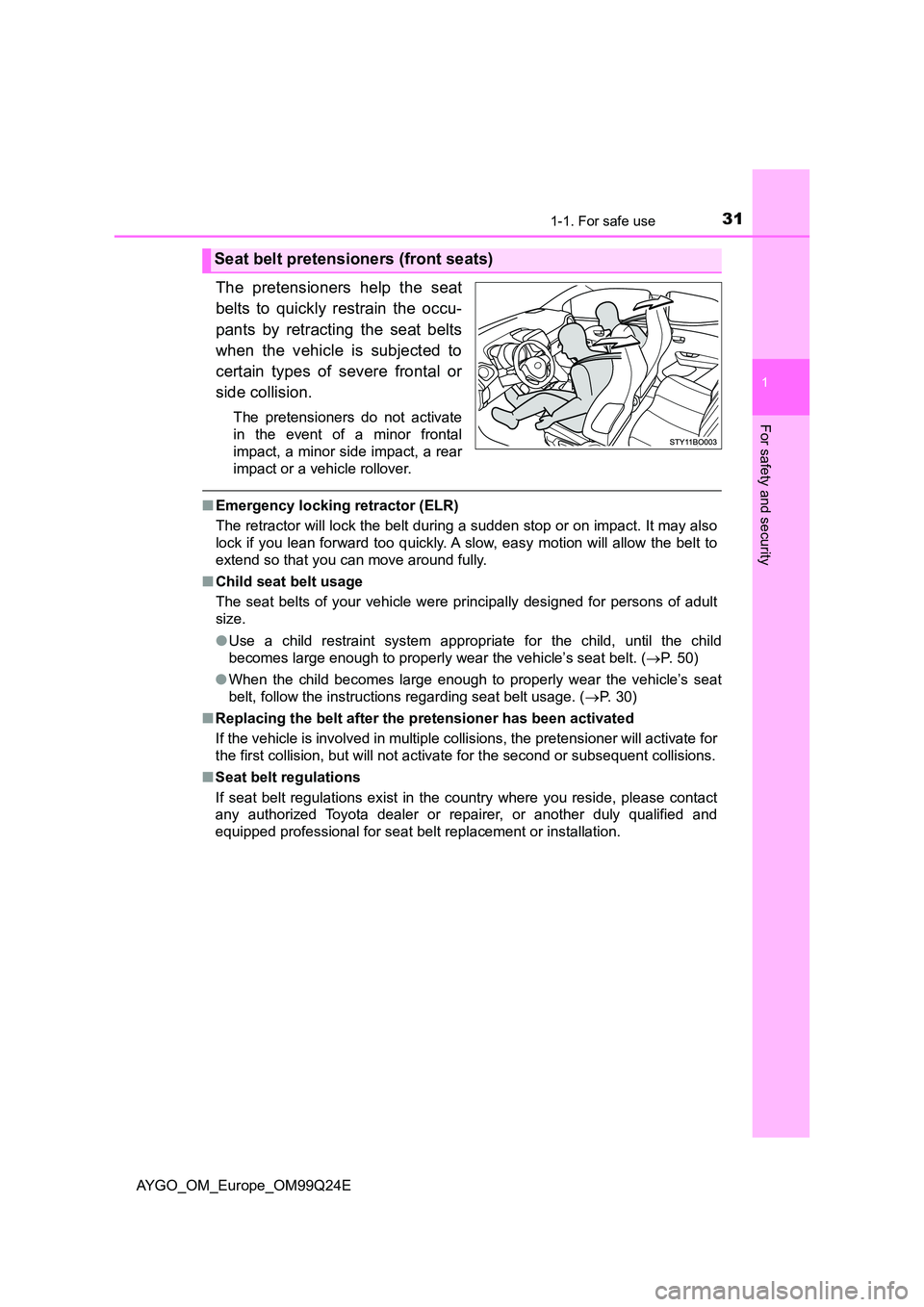
311-1. For safe use
1
For safety and security
AYGO_OM_Europe_OM99Q24E
The pretensioners help the seat
belts to quickly restrain the occu-
pants by retracting the seat belts
when the vehicle is subjected to
certain types of severe frontal or
side collision.
The pretensioners do not activate
in the event of a minor frontal
impact, a minor side impact, a rear
impact or a vehicle rollover.
■ Emergency locking retractor (ELR)
The retractor will lock the belt during a sudden stop or on impact. It may also
lock if you lean forward too quickly. A slow, easy motion will allow the belt to
extend so that you can move around fully.
■ Child seat belt usage
The seat belts of your vehicle were principally designed for persons of adult
size.
● Use a child restraint system appropriate for the child, until the child
becomes large enough to properly wear the vehicle’s seat belt. ( P. 5 0 )
● When the child becomes large enough to properly wear the vehicle’s seat
belt, follow the instructions regarding seat belt usage. ( P. 30)
■ Replacing the belt after the pretensioner has been activated
If the vehicle is involved in multiple collisions, the pretensioner will activate for
the first collision, but will not activate for the second or subsequent collisions.
■ Seat belt regulations
If seat belt regulations exist in the country where you reside, please contact
any authorized Toyota dealer or r epairer, or another duly qualified and
equipped professional for seat belt replacement or installation.
Seat belt pretensioners (front seats)
Page 32 of 480
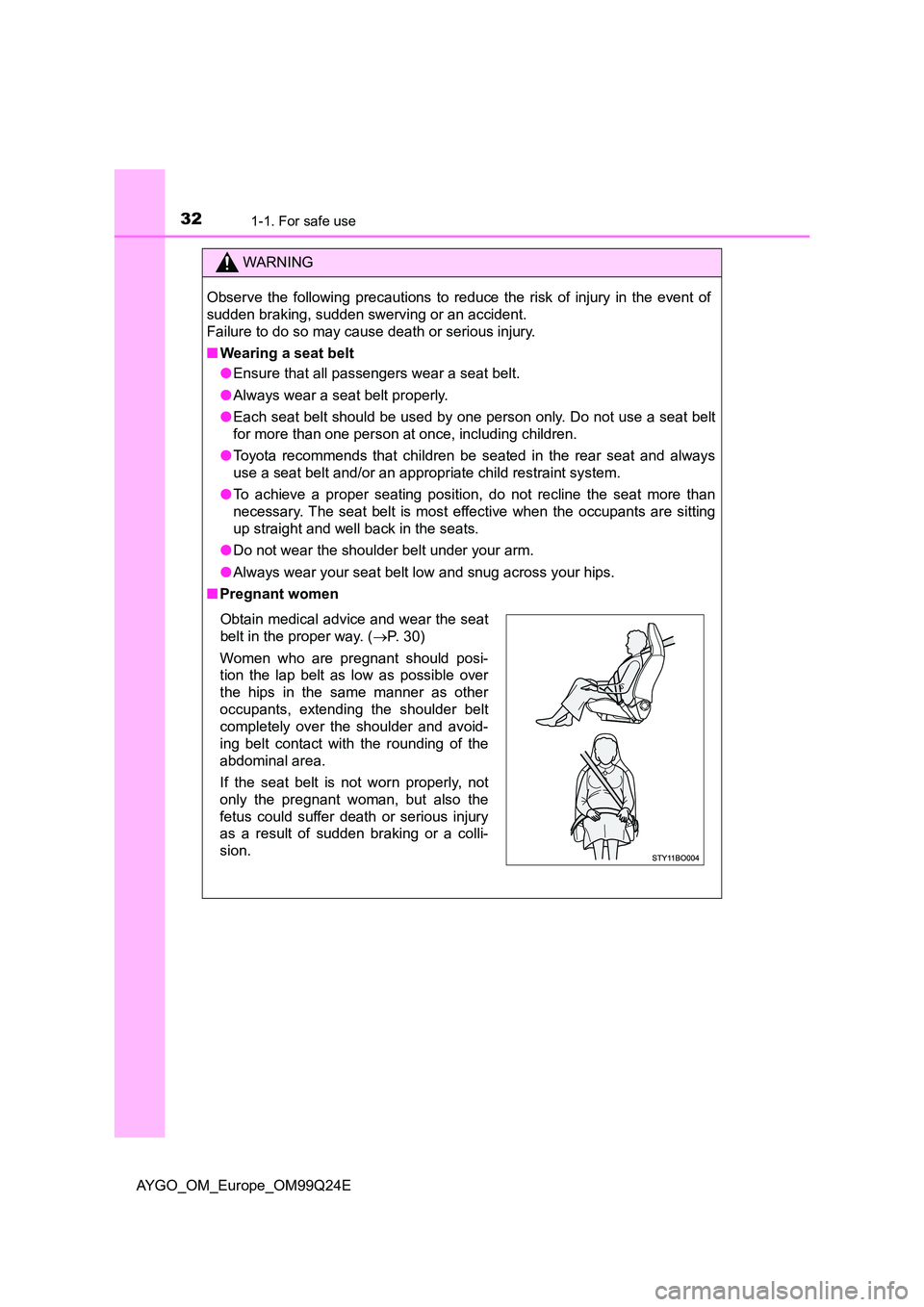
321-1. For safe use
AYGO_OM_Europe_OM99Q24E
WARNING
Observe the following precautions to reduce the risk of injury in the event of
sudden braking, sudden swerving or an accident.
Failure to do so may cause death or serious injury.
■ Wearing a seat belt
● Ensure that all passengers wear a seat belt.
● Always wear a seat belt properly.
● Each seat belt should be used by one person only. Do not use a seat belt
for more than one person at once, including children.
● Toyota recommends that children be seated in the rear seat and always
use a seat belt and/or an appropriate child restraint system.
● To achieve a proper seating position, do not recline the seat more than
necessary. The seat belt is most effective when the occupants are sitting
up straight and well back in the seats.
● Do not wear the shoulder belt under your arm.
● Always wear your seat belt low and snug across your hips.
■ Pregnant women
Obtain medical advice and wear the seat
belt in the proper way. ( P. 30)
Women who are pregnant should posi-
tion the lap belt as low as possible over
the hips in the same manner as other
occupants, extending the shoulder belt
completely over the shoulder and avoid-
ing belt contact with the rounding of the
abdominal area.
If the seat belt is not worn properly, not
only the pregnant woman, but also the
fetus could suffer death or serious injury
as a result of sudden braking or a colli-
sion.
Page 33 of 480
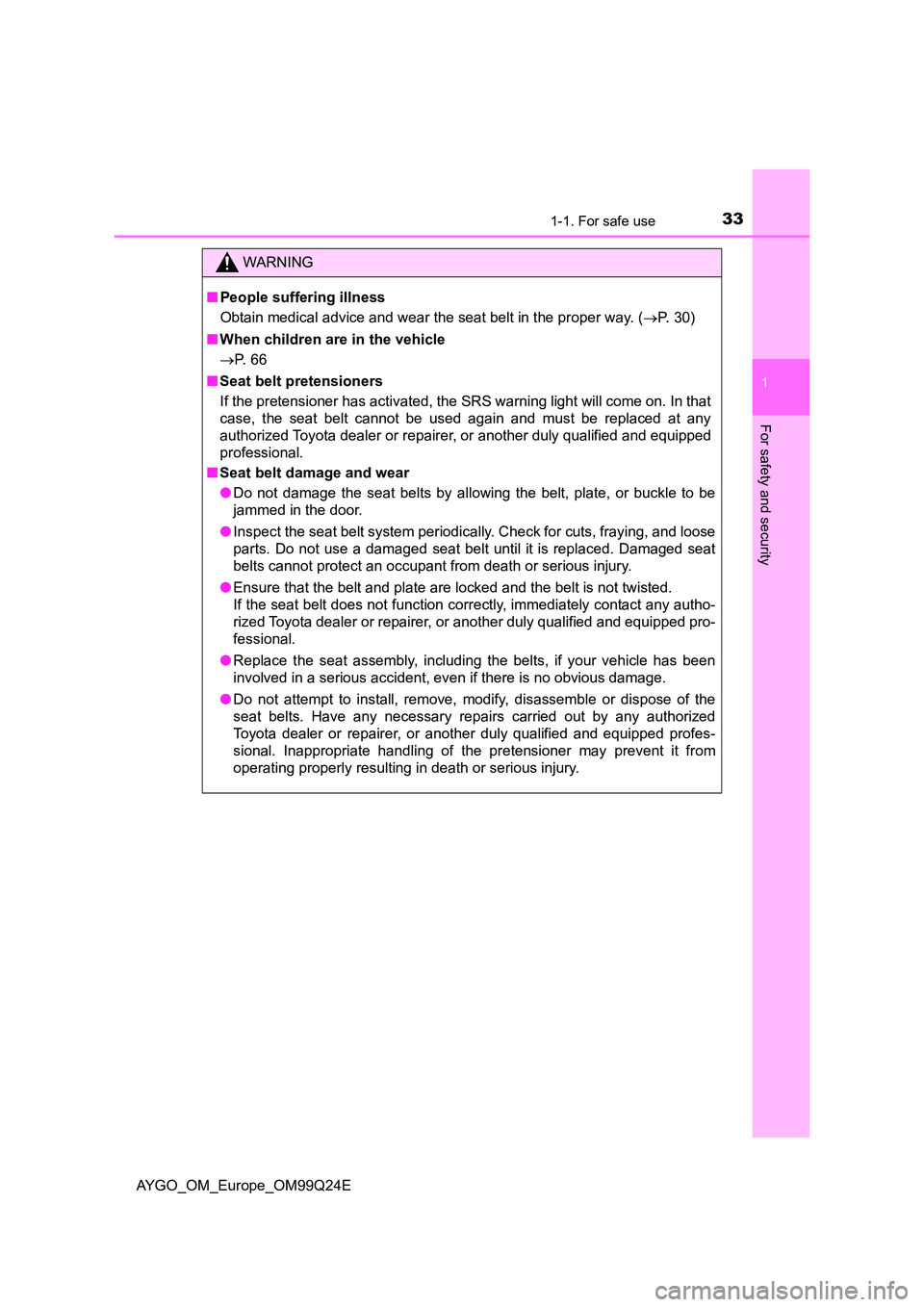
331-1. For safe use
1
For safety and security
AYGO_OM_Europe_OM99Q24E
WARNING
■People suffering illness
Obtain medical advice and wear the seat belt in the proper way. ( P. 30)
■ When children are in the vehicle
P. 6 6
■ Seat belt pretensioners
If the pretensioner has activated, the SRS warning light will come on. In that
case, the seat belt cannot be used again and must be replaced at any
authorized Toyota dealer or repairer, or another duly qualified and equipped
professional.
■ Seat belt damage and wear
● Do not damage the seat belts by allowing the belt, plate, or buckle to be
jammed in the door.
● Inspect the seat belt system periodically. Check for cuts, fraying, and loose
parts. Do not use a damaged seat belt until it is replaced. Damaged seat
belts cannot protect an occupant from death or serious injury.
● Ensure that the belt and plate are locked and the belt is not twisted.
If the seat belt does not function correctly, immediately contact any autho-
rized Toyota dealer or repairer, or another duly qualified and equipped pro-
fessional.
● Replace the seat assembly, including the belts, if your vehicle has been
involved in a serious accident, even if there is no obvious damage.
● Do not attempt to install, remove, modify, disassemble or dispose of the
seat belts. Have any necessary repairs carried out by any authorized
Toyota dealer or repairer, or another duly qualified and equipped profes-
sional. Inappropriate handling of the pretensioner may prevent it from
operating properly resulting in death or serious injury.
Page 34 of 480
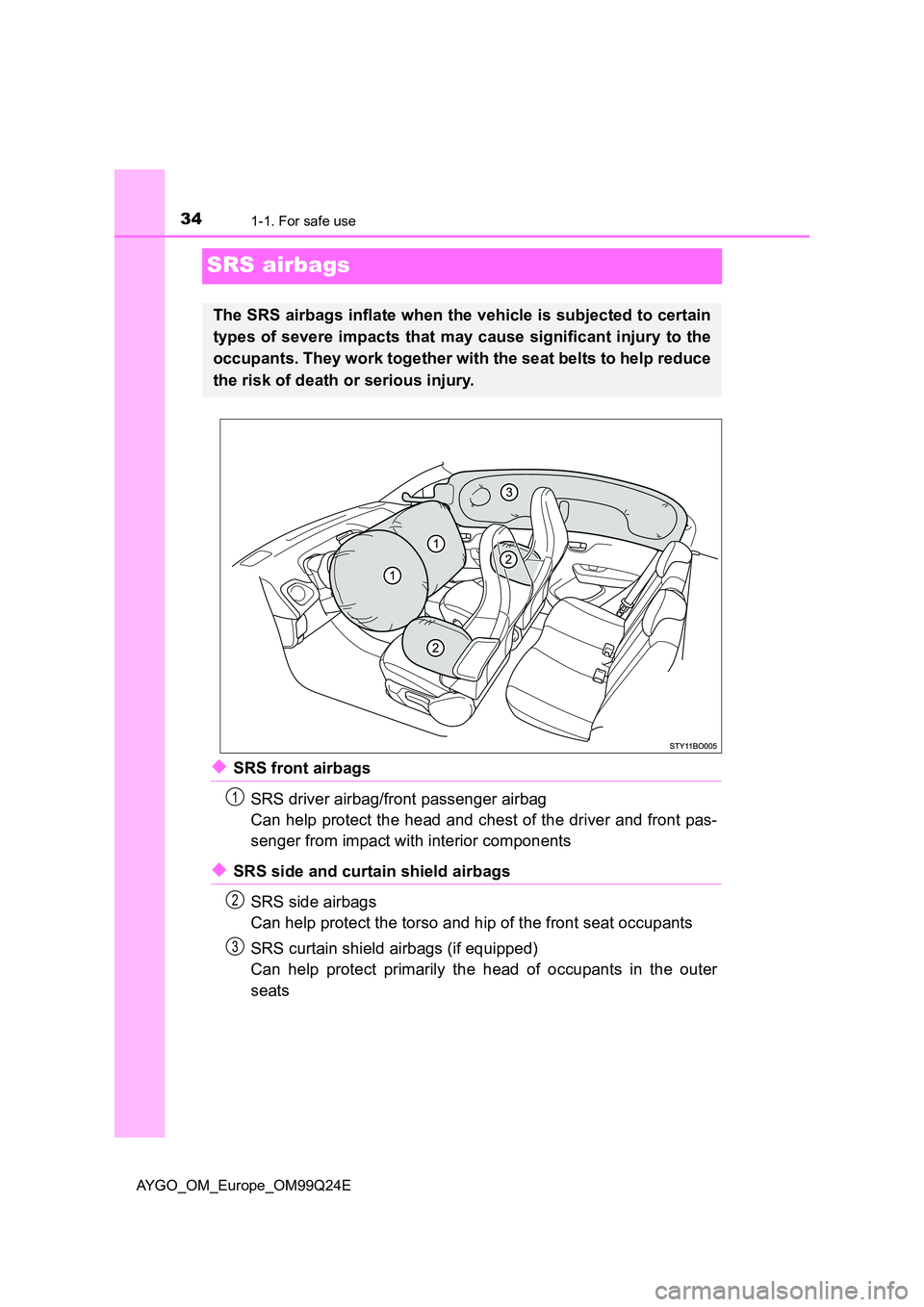
341-1. For safe use
AYGO_OM_Europe_OM99Q24E
SRS airbags
◆SRS front airbags
SRS driver airbag/front passenger airbag
Can help protect the head and chest of the driver and front pas-
senger from impact with interior components
◆SRS side and curtain shield airbags
SRS side airbags
Can help protect the torso and hip of the front seat occupants
SRS curtain shield airbags (if equipped)
Can help protect primarily the head of occupants in the outer
seats
The SRS airbags inflate when the vehicle is subjected to certain
types of severe impacts that may cause significant injury to the
occupants. They work together with the seat belts to help reduce
the risk of death or serious injury.
1
2
3
Page 35 of 480

351-1. For safe use
1
For safety and security
AYGO_OM_Europe_OM99Q24E
3-door models
SRS airbag system components
Front passenger airbag
Airbag manual on-off switch
“PASSENGER AIR BAG” indi-
cator light
Side airbags
SRS warning light
Curtain shield airbags
(if equipped)
Side impact sensors (rear)
(if equipped)
Seat belt pretensioners and
force limiters
Side impact sensors
(front doors)
Driver airbag
Airbag sensor assembly
Front impact sensor
1
2
3
4
5
6
7
8
9
10
11
12
Page 36 of 480
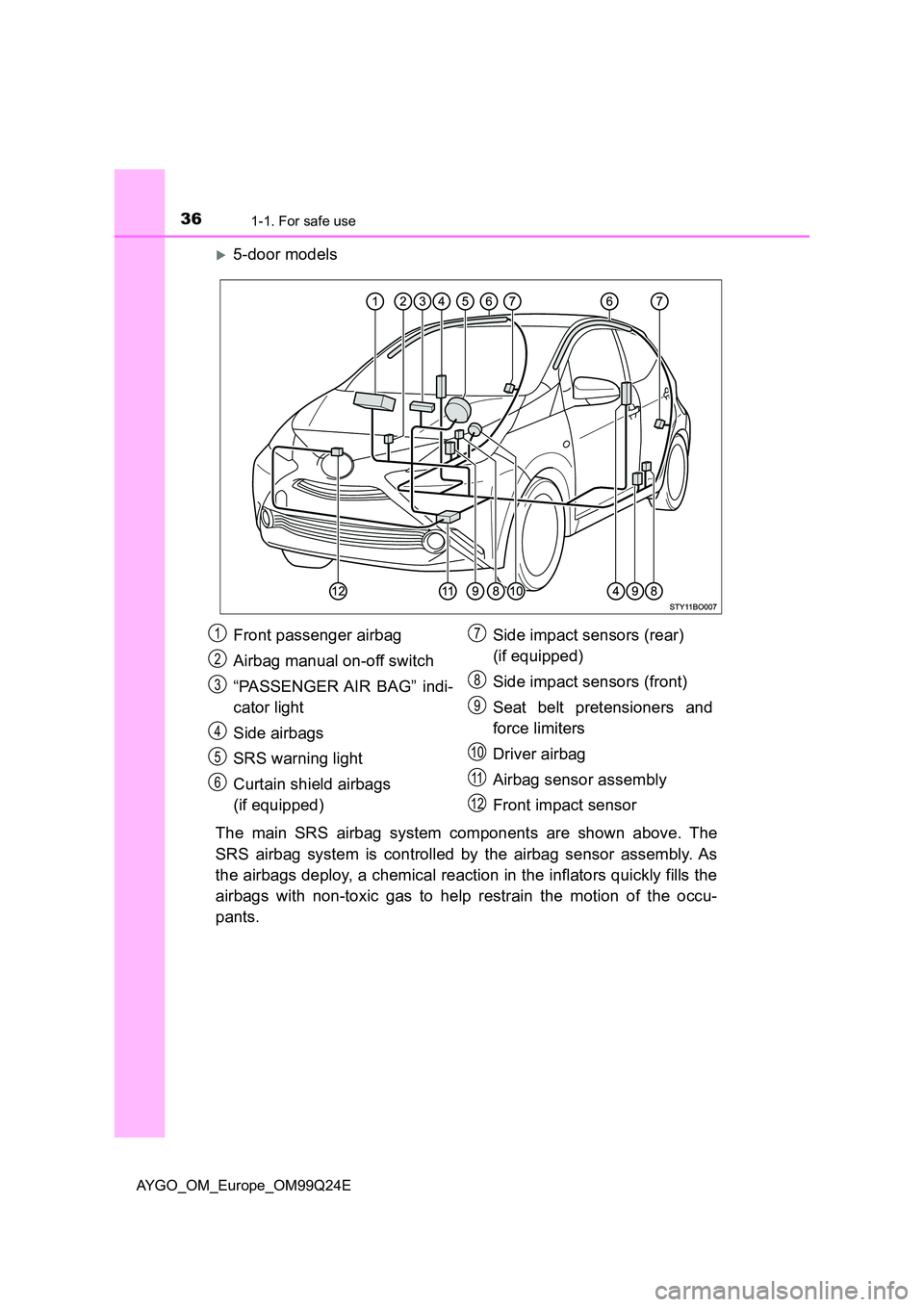
361-1. For safe use
AYGO_OM_Europe_OM99Q24E
5-door models
The main SRS airbag system components are shown above. The
SRS airbag system is controlled by the airbag sensor assembly. As
the airbags deploy, a chemical reaction in the inflators quickly fills the
airbags with non-toxic gas to help restrain the motion of the occu-
pants.
Front passenger airbag
Airbag manual on-off switch
“PASSENGER AIR BAG” indi-
cator light
Side airbags
SRS warning light
Curtain shield airbags
(if equipped)
Side impact sensors (rear)
(if equipped)
Side impact sensors (front)
Seat belt pretensioners and
force limiters
Driver airbag
Airbag sensor assembly
Front impact sensor
1
2
3
4
5
6
7
8
9
10
11
12
Page 37 of 480
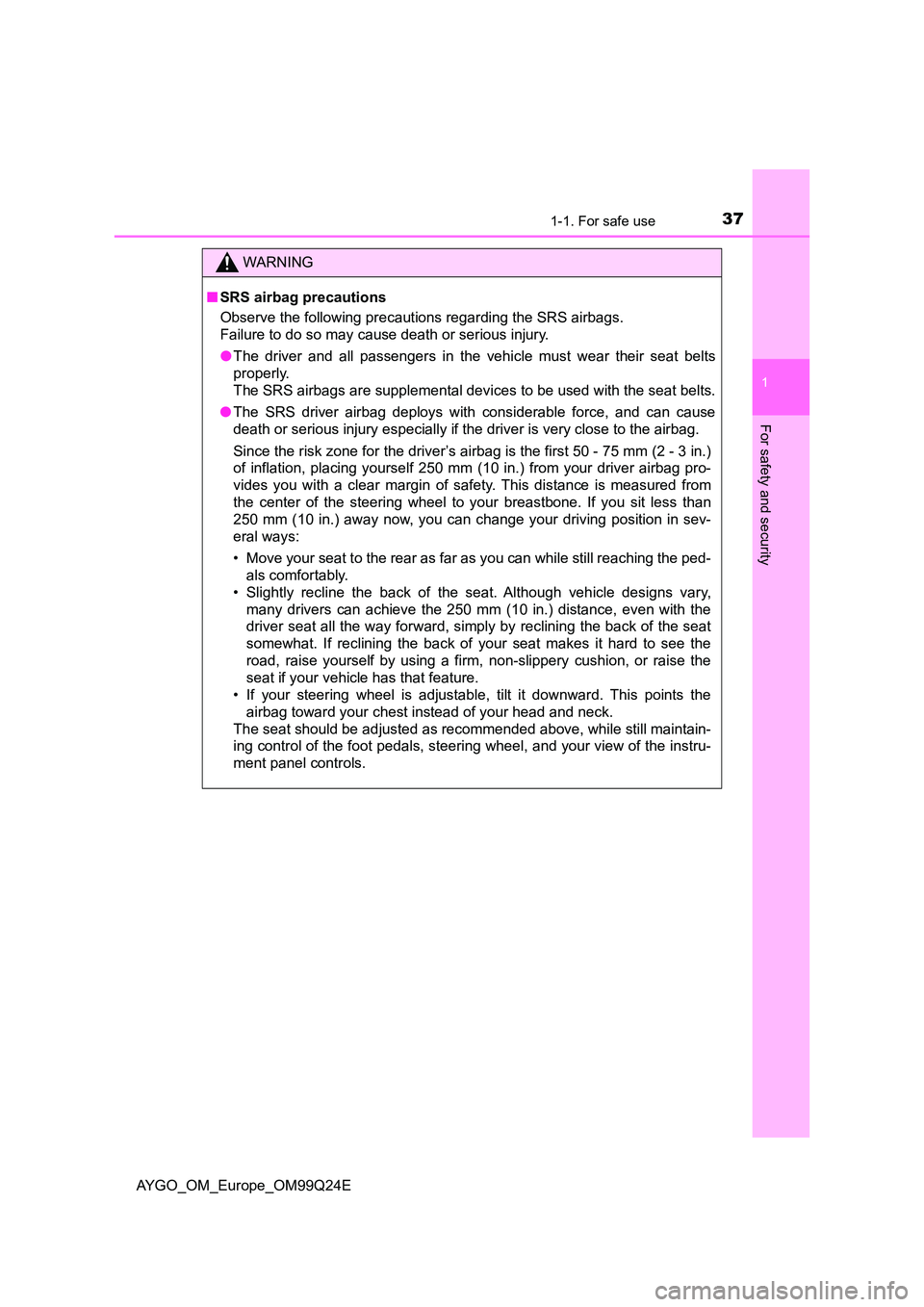
371-1. For safe use
1
For safety and security
AYGO_OM_Europe_OM99Q24E
WARNING
■SRS airbag precautions
Observe the following precautions regarding the SRS airbags.
Failure to do so may cause death or serious injury.
● The driver and all passengers in the vehicle must wear their seat belts
properly.
The SRS airbags are supplemental devic es to be used with the seat belts.
● The SRS driver airbag deploys with considerable force, and can cause
death or serious injury especially if the driver is very close to the airbag.
Since the risk zone for the driver’s airbag is the first 50 - 75 mm (2 - 3 in.)
of inflation, placing yourself 250 mm ( 10 in.) from your driver airbag pro-
vides you with a clear margin of safety. This distance is measured from
the center of the steering wheel to your breastbone. If you sit less than
250 mm (10 in.) away now, you can change your driving position in sev-
eral ways:
• Move your seat to the rear as far as you can while still reaching the ped-
als comfortably.
• Slightly recline the back of the seat. Although vehicle designs vary,
many drivers can achieve the 250 mm (10 in.) distance, even with the
driver seat all the way forward, simply by reclining the back of the seat
somewhat. If reclining the back of your seat makes it hard to see the
road, raise yourself by using a firm, non-slippery cushion, or raise the
seat if your vehicle has that feature.
• If your steering wheel is adjustable, tilt it downward. This points the
airbag toward your chest instead of your head and neck.
The seat should be adjusted as recommended above, while still maintain-
ing control of the foot pedals, steering wheel, and your view of the instru-
ment panel controls.
Page 38 of 480
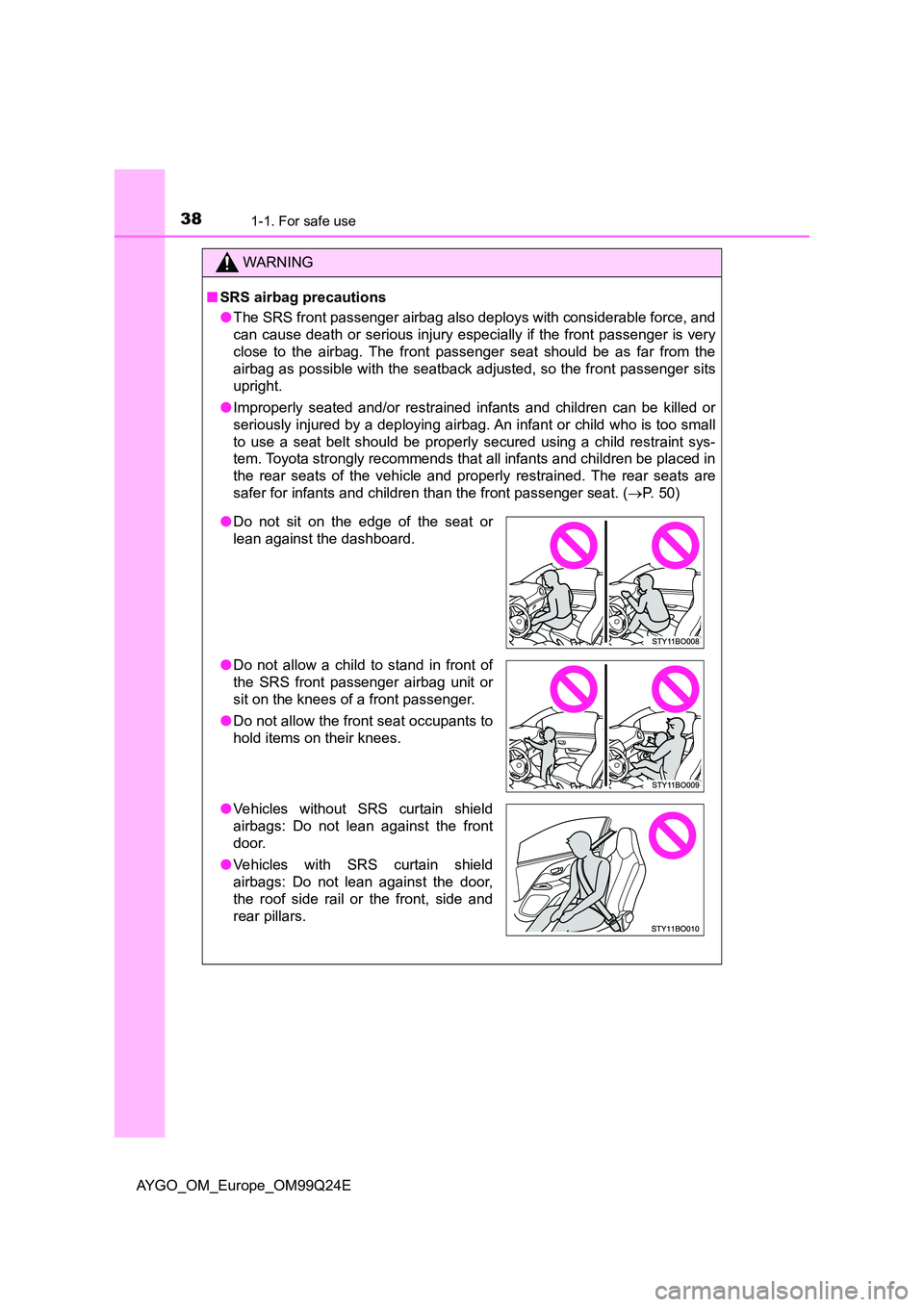
381-1. For safe use
AYGO_OM_Europe_OM99Q24E
WARNING
■SRS airbag precautions
● The SRS front passenger airbag also deploys with considerable force, and
can cause death or serious injury especially if the front passenger is very
close to the airbag. The front passenger seat should be as far from the
airbag as possible with the seatback adjusted, so the front passenger sits
upright.
● Improperly seated and/or restrained infants and children can be killed or
seriously injured by a deploying airbag. An infant or child who is too small
to use a seat belt should be properly secured using a child restraint sys-
tem. Toyota strongly recommends that all infants and children be placed in
the rear seats of the vehicle and proper ly restrained. The rear seats are
safer for infants and children than the front passenger seat. ( P. 50)
●Do not sit on the edge of the seat or
lean against the dashboard.
● Do not allow a child to stand in front of
the SRS front passenger airbag unit or
sit on the knees of a front passenger.
● Do not allow the front seat occupants to
hold items on their knees.
● Vehicles without SRS curtain shield
airbags: Do not lean against the front
door.
● Vehicles with SRS curtain shield
airbags: Do not lean against the door,
the roof side rail or the front, side and
rear pillars.
Page 39 of 480
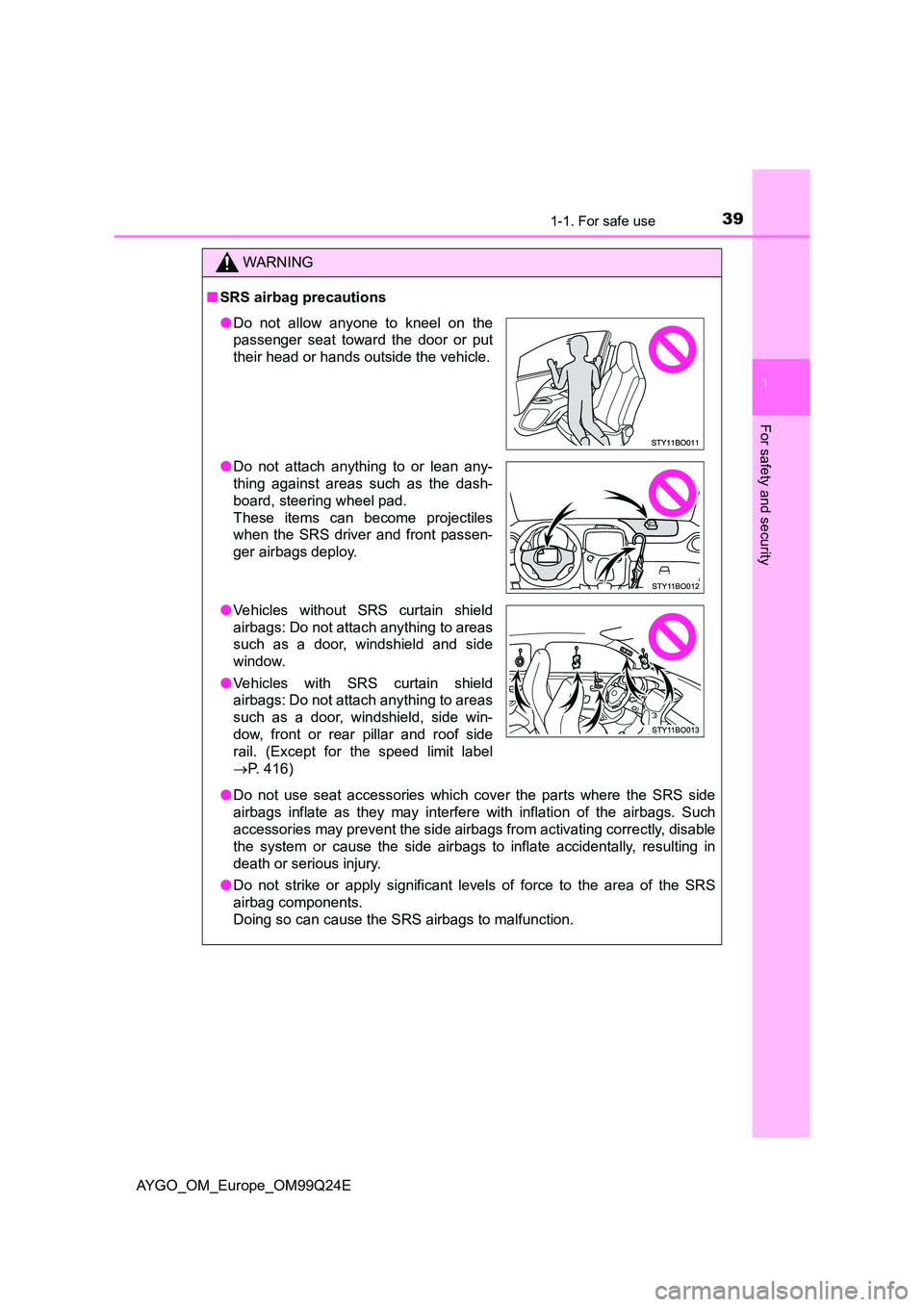
391-1. For safe use
1
For safety and security
AYGO_OM_Europe_OM99Q24E
WARNING
■SRS airbag precautions
● Do not use seat accessories which cover the parts where the SRS side
airbags inflate as they may interfere with inflation of the airbags. Such
accessories may prevent the side airbags from activating correctly, disable
the system or cause the side airbags to inflate accidentally, resulting in
death or serious injury.
● Do not strike or apply significant levels of force to the area of the SRS
airbag components.
Doing so can cause the SRS airbags to malfunction.
● Do not allow anyone to kneel on the
passenger seat toward the door or put
their head or hands outside the vehicle.
● Do not attach anything to or lean any-
thing against areas such as the dash-
board, steering wheel pad.
These items can become projectiles
when the SRS driver and front passen-
ger airbags deploy.
● Vehicles without SRS curtain shield
airbags: Do not attach anything to areas
such as a door, windshield and side
window.
● Vehicles with SRS curtain shield
airbags: Do not attach anything to areas
such as a door, windshield, side win-
dow, front or rear pillar and roof side
rail. (Except for the speed limit label
P. 416)
Page 40 of 480
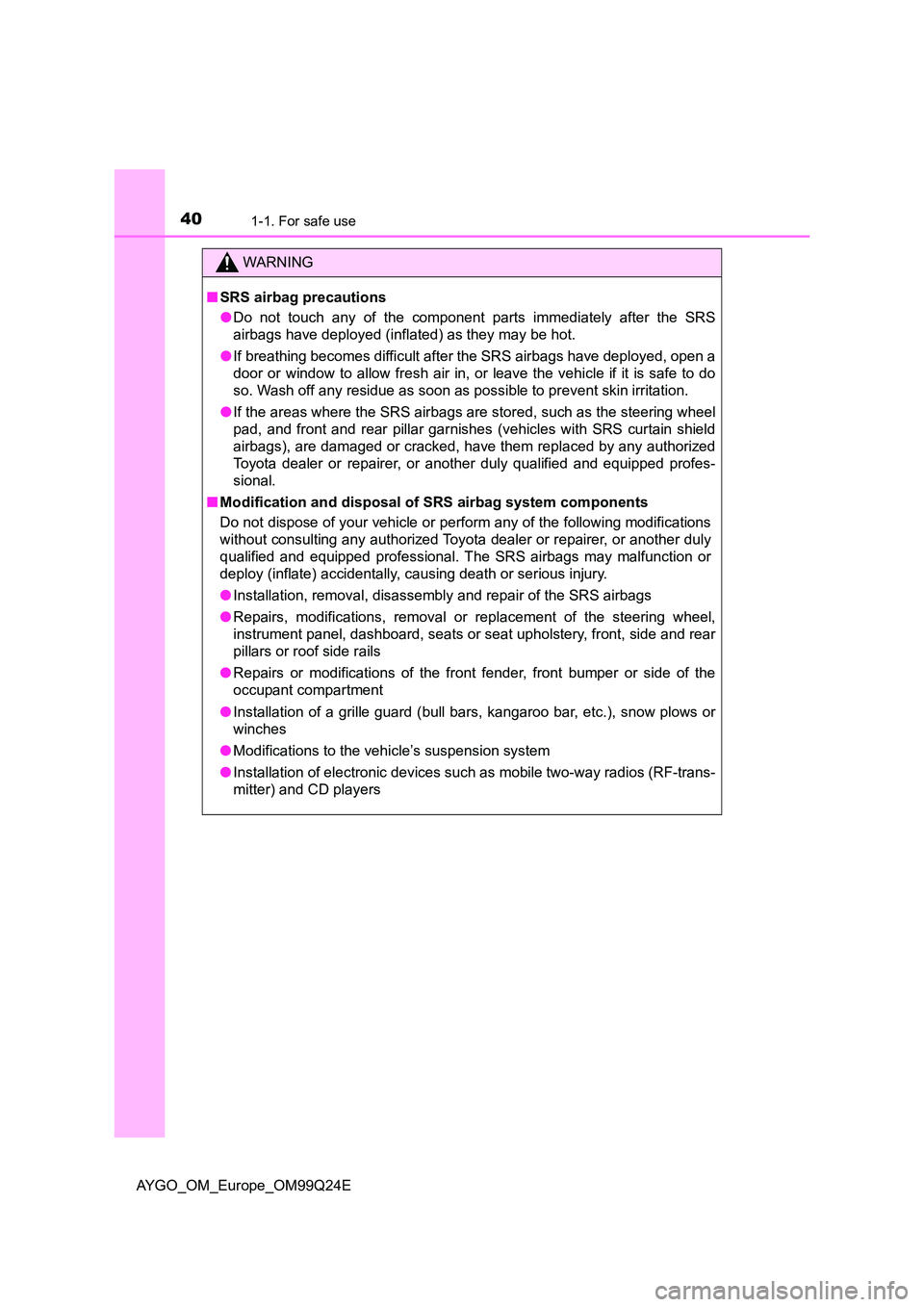
401-1. For safe use
AYGO_OM_Europe_OM99Q24E
WARNING
■SRS airbag precautions
● Do not touch any of the component parts immediately after the SRS
airbags have deployed (inflated) as they may be hot.
● If breathing becomes difficult after the SRS airbags have deployed, open a
door or window to allow fresh air in, or leave the vehicle if it is safe to do
so. Wash off any residue as soon as possible to prevent skin irritation.
● If the areas where the SRS airbags are stored, such as the steering wheel
pad, and front and rear pillar garnishes (vehicles with SRS curtain shield
airbags), are damaged or cracked, have them replaced by any authorized
Toyota dealer or repairer, or another duly qualified and equipped profes-
sional.
■ Modification and disposal of SRS airbag system components
Do not dispose of your vehicle or perform any of the following modifications
without consulting any authorized Toyota dealer or repairer, or another duly
qualified and equipped professional. The SRS airbags may malfunction or
deploy (inflate) accidentally, causing death or serious injury.
● Installation, removal, disassembly and repair of the SRS airbags
● Repairs, modifications, removal or replacement of the steering wheel,
instrument panel, dashboard, seats or seat upholstery, front, side and rear
pillars or roof side rails
● Repairs or modifications of the front fender, front bumper or side of the
occupant compartment
● Installation of a grille guard (bull bars, kangaroo bar, etc.), snow plows or
winches
● Modifications to the vehicle’s suspension system
● Installation of electronic devices such as mobile two-way radios (RF-trans-
mitter) and CD players